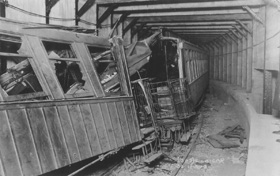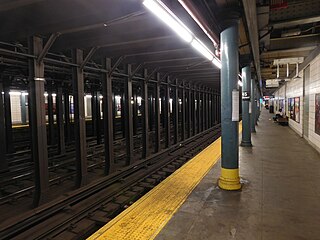
Bus rapid transit (BRT), also called a busway or transitway, is a bus-based public transport system designed to have better capacity and reliability than a conventional bus system. Typically, a BRT system includes roadways that are dedicated to buses, and gives priority to buses at intersections where buses may interact with other traffic; alongside design features to reduce delays caused by passengers boarding or leaving buses, or paying fares. BRT aims to combine the capacity and speed of a metro with the claimed flexibility, lower cost and simplicity of a bus system.

The Malbone Street wreck, also known as the Brighton Beach Line accident, was a rapid transit railroad accident that occurred on November 1, 1918, on the New York City Subway's BMT Brighton Line in the community of Flatbush in Brooklyn, New York, United States. A speeding train derailed in the sharply curved tunnel beneath Willink Plaza, the intersection of Flatbush Avenue, Ocean Avenue, and Malbone Street. At least 93 people died, making it one of the deadliest train crashes in U.S. history, as well as the deadliest in the history of the New York City Subway.

The Dual Contracts, also known as the Dual Subway System, were contracts for the construction and/or rehabilitation and operation of rapid transit lines in the City of New York. The contracts were signed on March 19, 1913, by the Interborough Rapid Transit Company and the Brooklyn Rapid Transit Company. As part of the Dual Contracts, the IRT and BRT would build or upgrade several subway lines in New York City, then operate them for 49 years.

The Brooklyn Rapid Transit Company (BRT) was a public transit holding company formed in 1896 to acquire and consolidate railway lines in Brooklyn and Queens, New York City, United States. It was a prominent corporation and industry leader using the single-letter symbol B on the New York Stock Exchange. It operated both passenger and freight services on its rail rapid transit, elevated and subway network, making it unique among the three companies which built and operated subway lines in New York City. It became insolvent in 1919 and was restructured and released from bankruptcy as the Brooklyn–Manhattan Transit Corporation in 1923.

TransMilenio is a bus rapid transit (BRT) system that serves Bogotá, the capital of Colombia, and Soacha. The system opened to the public in December 2000, covering Caracas Avenue and 80 street. Other lines were added gradually over the next several years, and as of 2022, 12 lines totalling 114.4 km (71 mi) run throughout the city. It is part of the city's Integrated Public Transport System, along with the urban, complementary and special bus services operating on neighbourhoods and main streets.

The Brooklyn City Railroad (BCRR) was the oldest and one of the largest operators of streetcars in the City of Brooklyn, New York, continuing in that role when Brooklyn became a borough of New York City in 1898.
Starting in 1899, the Brooklyn Rapid Transit Company and Brooklyn–Manhattan Transit Corporation operated rapid transit lines in New York City — at first only elevated railways and later also subways.

The 59th Street station is an express station on the BMT Fourth Avenue Line of the New York City Subway. Located at 59th Street and Fourth Avenue in Sunset Park, Brooklyn, it is served by the N and R trains at all times. During rush hours, several W and northbound Q trains also serve the station.

The 45th Street station is a local station on the BMT Fourth Avenue Line of the New York City Subway. Located at 45th Street and Fourth Avenue in Sunset Park, Brooklyn, it is served by the R train at all times. The N train also stops here during late nights, and some rush-hour W trains stop here in the peak direction.

The 77th Street station is a station on the BMT Fourth Avenue Line of the New York City Subway. Located at 77th Street and Fourth Avenue in Bay Ridge, Brooklyn, it is served by the R train at all times.
Richard Lee Strout was an American journalist and commentator. He was national correspondent for the Christian Science Monitor from 1923 and he wrote the "TRB from Washington" column for The New Republic from 1943 to 1983; he collected the best of his columns in TRB: Views and Perspectives on the Presidency, a book notable for showing that Strout was one of the first observers of the American presidency to express worry about what later scholars and journalists came to call the imperial presidency.

The 25th Street station is a local station on the BMT Fourth Avenue Line of the New York City Subway. Located at the intersection of 25th Street and Fourth Avenue in Greenwood Heights, Brooklyn, it is served by the R train at all times. The D and N trains also stop here during late nights, and some rush-hour W trains stop here in the peak direction.

The Cebu Bus Rapid Transit System is a planned mass transit system for Cebu City located within the greater Cebu Metropolitan Area. It is expected to become the first operational bus rapid transit project in the Philippines. Only one line has been planned in detail so far, but scheme developers note the potential to develop a larger network comprising the adjacent cities Lapu-Lapu, Mandaue and Talisay. Leadership in both Lapu-Lapu and Mandaue have shown interest in the network. This will be constructed at the end or last quarter of 2017 and the first route could be operational by the end of 2019.

Bus rapid transit creep is a phenomenon commonly defined as a bus rapid transit (BRT) system that fails to meet the requirements to be considered "true BRT". These systems are often marketed as a fully realized bus rapid transit system, but end up being described as more of an improvement to regular bus service by proponents of the "BRT creep" term. Notably, the ITDP published several guidelines in an attempt to define what constitutes the term of "true BRT", known as the BRT Standard, in an attempt to avert this phenomenon.

The BRT Sunway Line is a bus rapid transit (BRT) line that is part of the Klang Valley Integrated Transit System servicing the southeastern suburbs of Petaling Jaya, Malaysia. It is world's first all-electric Bus Rapid Transit system.
The BRT Kota Kinabalu is a bus rapid transit (BRT) project to improve bus services in the city of Kota Kinabalu. An allocation of around MYR1 billion has been provided by the Malaysian government under the 2016 Malaysian Budget to implement the project. Currently, the project is under studies between the federal and state governments and it was predicted to be finished in 2020. It has also been lauded by the Prasarana Malaysia, the government-owned company specialise in bus and light metro development, the Chief Minister of Sabah, Musa Aman and various other politicians who said they have been waited for almost 10 years.

The New York City Board of Transportation or the Board of Transportation of the City of New York was a city transit commission and operator in New York City, consisting of three members appointed by the mayor. It was created in 1924 to control city-owned and operated public transportation service within the New York City Transit System. The agency oversaw the construction and operation of the municipal Independent Subway System (IND), which was constructed shortly after the Board was chartered. The BOT later presided over the major transfers of public transit from private control to municipal control that took place in the 1940s, including the unification of the New York City Subway in 1940. In 1953, the Board was dissolved and replaced by the state-operated New York City Transit Authority, now part of the Metropolitan Transportation Authority (MTA).

The Central Power Station of the Brooklyn Rapid Transit Company building, commonly known as the Batcave or Gowanus Batcave, is a former transit power station at 153 Second Street in Gowanus, Brooklyn, New York City by the Gowanus Canal. It was built between 1901 and 1904, while the Brooklyn Rapid Transit Company was expanding its rapid transit and streetcar service. It stopped operating in 1972 and sat abandoned for more than two decades, becoming home to a community of squatters in the early 2000s. The owners, who were planning to redevelop the site, building condominiums called "Gowanus Village", had the squatters removed and increased security in 2006. The Gowanus Village plans did not materialize and after a short time it became a popular space for graffiti and underground events.

The METRO C Line is a bus rapid transit line in Brooklyn Center and Minneapolis, Minnesota operated by Metro Transit. The line is part of Metro Transit's METRO network of light rail and bus rapid transit lines. The route operates from the Brooklyn Center Transit Center along Penn Avenue and Olson Memorial Highway, terminating in downtown Minneapolis. The route is analogous to the existing Route 19 and is projected to increase ridership on this corridor from 7,000 to 9,000 by 2030. Eventually, part of its route will shift south to Glenwood Avenue from Olson Memorial Highway.

CMAX is a bus rapid transit (BRT) service in Central Ohio, operated by the Central Ohio Transit Authority (COTA). The line begins in Downtown Columbus, traveling northeast to Westerville. CMAX is Central Ohio's first bus rapid transit line; it began operation in 2018.
















